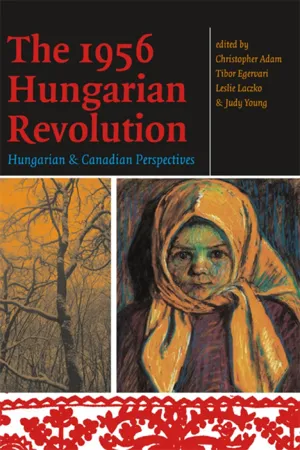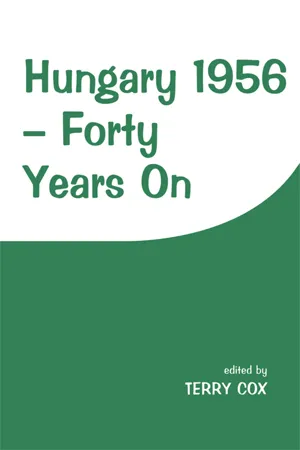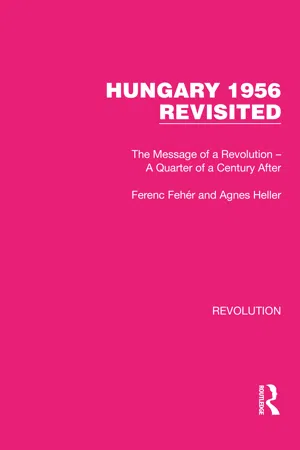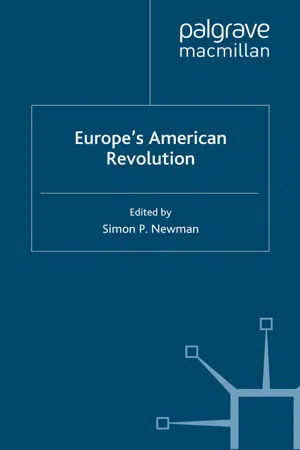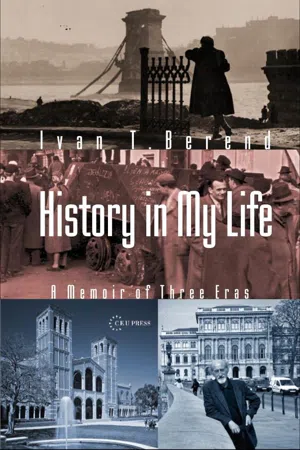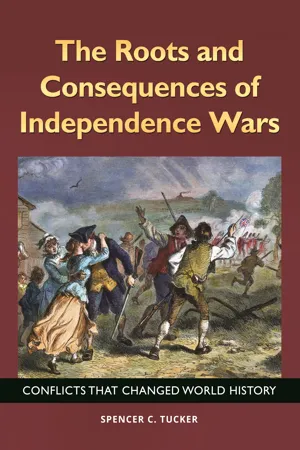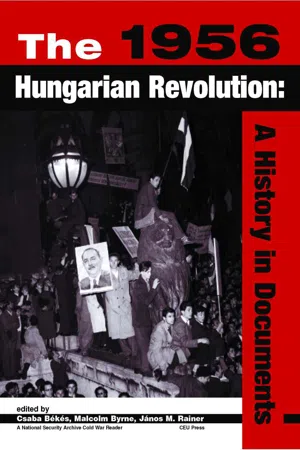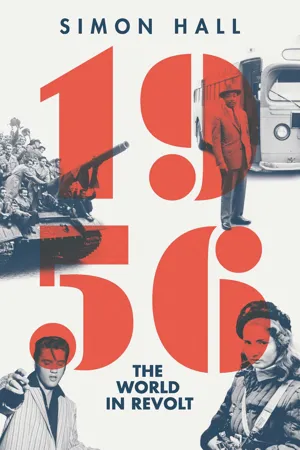History
Hungarian Revolution
The Hungarian Revolution of 1956 was a nationwide uprising against the Soviet-backed Hungarian People's Republic and its policies. It began as a student demonstration and quickly escalated into a full-scale revolution, with demands for political reform and the withdrawal of Soviet forces. The revolution was ultimately crushed by the Soviet Union, but it had a lasting impact on Hungarian politics and inspired other anti-Soviet movements across Eastern Europe.
Written by Perlego with AI-assistance
Related key terms
1 of 5
12 Key excerpts on "Hungarian Revolution"
- eBook - ePub
- Christopher Adam, Tibor Egervari, Leslie Laczko, Judy Young(Authors)
- 2010(Publication Date)
- University of Ottawa Press(Publisher)
Part I The Revolution, Hungary, and the WorldPassage contains an image
1.The Hungarian Revolution of 1956: Causes, Aims, and Course of EventsJános M. RainerO n October 23, 1956, a revolution broke out in Budapest and spread all over the country in just a few days. The demonstrators, strikers, armed insurgents, leaders of the organizations of the revolution, and their sympathizers, demanded democratic freedoms and national independence. The first modern anti-totalitarian revolution in Europe lasted for practically two weeks, with another four weeks of rear-guard actions. Its impact could, however, be felt directly or indirectly for decades to come, right up to the change of regimes in 1989–1990.I offer here a survey of the antecedents of 1956 from the point of view of political and social history, as well as the history of ideas. This is followed by a brief history of the revolution and an outline of the strata of active participants. Finally, I attempt to characterize the revolutionaries’ aims.AntecedentsThe need for political, economic, social, and mental change became a constant concern of Hungarian public life from the early 1930s, when the Great Depression began to make an impact in Hungary. The solution to the agrarian question, in the form of land reform, was a perennial topic from the end of World War I onward. The great economic crisis and the outbreak of World War II gave an impetus to reformist thinking, as it became obvious that Hungary would necessarily emerge from the war a different country. The dimensions of the war made it clear that Hungary’s subsequent fate would be greatly determined by the superpower in control of the East-central European region.In 1944 Hungary became part of the Soviet sphere of influence. This fundamentally determined Hungary’s domestic and foreign policy, as well as its social and economic development between 1944 and the late 1980s. All issues that were believed to interfere with Soviet military and political interests and security were decided by the Soviets. Hungarian political life was independent as long as it did not go beyond the limits of this system and remained in harmony with Soviet demands. Whenever a conflict arose, Soviet interests enjoyed absolute priority.1 - eBook - ePub
- Árpád von Klimó, Kevin McAleer(Authors)
- 2017(Publication Date)
- Taylor & Francis(Publisher)
1 1956 – key event in Hungarian postwar historyThere are only a very few things about which people are unanimous with regard to the events that took place between 23 October and 4 November 1956. Among these is that those events were of national and world-historical importance. Indeed, what is today officially known in Hungary as “the revolution and struggle for freedom” is the event of recent Hungarian history – an episode that for a short while made the country the focus of the world’s attention. “That capital year in the history of communism,” summarized François Furet, “had two consequences: the bloc began to disintegrate and its unified myth lost its credibility.” The first aspect concerns Soviet-dominated Eastern Europe, and the second the numerous intellectuals and workers in Eastern and Western Europe who were sympathetic toward the Soviet Union, not least because of Stalin’s triumph over Hitler. Both of these factors changed in a fairly abrupt fashion in the autumn of 1956.At first glance, an interpretation of 1956 would seem to be very simple – the white and black hats would seem to be so clearly assigned: A world power of titanic dimensions employs its massive military might to suppress a popular protest movement in a small Central European country, topples a government head that they themselves had placed in power shortly before, and transfers power to an unscrupulous functionary who proceeds to exact bloody revenge against thousands of dissidents. Small wonder that the world was overwhelmingly pulling for the Hungarian freedom fighters, even if Western Europe and the United States never seriously considered fighting alongside these Hungarians in order to decisively change the status quo in Eastern Europe. And another thing is clear: The precise meaning of those events of 1956 is still vehemently debated, in particular ever since 1989. In 2010, Viktor Orbán called 1956 “the unfinished revolution,” the “ongoing struggle” that ended only with the landslide victory of his party. At the occasion of the sixtieth anniversary in 2016, he emphasized that in 1956 Hungarian freedom fighters had “changed the course of history,” which suggests that the dramatic changes of 1989 were less important. However, both dates are closely related. - eBook - ePub
Hungary 1956
Forty Years On
- Terry Cox(Author)
- 2014(Publication Date)
- Routledge(Publisher)
First, we should note that it has only been in the past few years, following a revision of the official view of 1956 by the ruling communist leadership in 1989, that researchers in Hungary have been able to discuss the events of 1956 openly as a revolution. This has been significant in removing artificial fetters on the scope of their inquiries and enabling them to enter into a dialogue with colleagues elsewhere in a context in which they can share and debate the same terminology and conceptualizations. Second, democratization and greater freedom of information in the 1990s have also enabled researchers to gain access to archives and document collections that were previously closed to them, not only in Hungary but also in the Soviet Union and a number of Western countries. This has led to the publication of a range of articles shedding new light on aspects of the decisions and processes underlying the events of 1956. Third, the political changes since the end of the 1980s have created a more supportive climate in which to carry out oral history and to begin to draw on popular memories of how the revolution was intertwined with everyday life and experiences. Finally, interconnected with this range of new research a wider political debate has taken place on the meaning of the 1956 revolution for present-day Hungary and the extent to which it can provide a basis for the creation of a new tradition to legitimate the newly emerged Hungarian political system. To varying degrees the articles collected in this volume reflect these various developments.The Nature and Origins of the 1956 RevolutionThe historical significance of the events of 1956 in Hungary has been widely recognized ever since they first took place. A major reason for this is that, apart from the very early years of communist rule in the Soviet Union, it was the first occasion in which a communist regime met a major challenge from a widespread mass opposition movement. Although linked in its causes and grievances to other expressions of popular discontent and opposition in the years after the death of Stalin – in East Germany, Czechoslovakia, and most notably Poland – the Hungarian events were distinctive in their nature and consequences. In particular they were exceptional in giving birth to a sustained mass movement that briefly promised a genuine share of state power to non-communist parties and the prospect of a radical restructuring of social relations and institutions throughout Hungarian society.The prospects for such radical restructuring that were opened up by the events of 1956 immediately raised the question of whether they could be seen as a revolution. In the years since then there has been much debate on this question but, in essence, three main objections have emerged to the description of 1956 as a revolution. - eBook - ePub
Hungary 1956 Revisited
The Message of a Revolution – A Quarter of a Century After
- Ferenc Fehér, Agnes Heller(Authors)
- 2022(Publication Date)
- Routledge(Publisher)
2 The Impact on Hungary
(i) The Hungarian Revolution: A ‘Simple Matter’?
There is a tendency among professional and non-professional interpreters of the Hungarian Revolution to simplify matters with regard to its meaning. Some call it a ‘simple matter’ of restoring national freedom, a ‘national revolution’; others an equally ‘simple matter’ of restoring political liberties, a ‘liberal revolution’. But the two concepts are not, and never have been, co-extensive, and this ‘simple matter’ is somewhat more involved. There is a third interpretation, the simplest of all. Cardinal Mindszenty, in a speech broadcast on the evening of 3 November, radically denied the revolutionary character of the events. (Apart from its arch-conservatism, the speech was notable for its being perhaps the most monumental blunder in the histories of modern revolutions in that it provided inexhaustible material for the enemy - in this case, for the Soviet and pro-Soviet propaganda.) For Mindszenty, it was a ‘fight for freedom’. Though it is of course true, and understandably so, that for the genuinely restorative and conservative forces the term ‘revolution’ was unacceptable in any sense, given that the overwhelming majority of the population unhesitatingly termed the events ‘revolutionary’ we are still left with a problem, and one that is far from being of a purely semantic nature.In judging the arguments for and against the thesis that characterises October 1956 as a ‘national revolution’, we must set aside any formal definition of the term ‘revolution’ (as against ‘rebellion’, ‘revolt’, ‘uprising’), as well as the verbal pyrotechnics distinguishing wars of national independence and social revolutions: these are grossly sterile enterprises. It is beyond all doubt that the fight for national independence stood at the pinnacle of those celebrated thirteen days for the very simple reason that every change had to be fought for against the military presence and oppressive role of the Soviet army. At this point it must be understood as absolute fact (this issue was much debated in the assessment of Imre Nagy’s political character) that the Soviet army intervened prior to any Hungarian appeal that it received, and particularly prior to any consent to intervention given by Nagy (to put his name to the appeal), and that the Soviet Presidium and their Hungarian emissary, Andropov, were already the real repositories of power on the night of 23 October.1 Apart from a few murderous attacks of the hated ‘Blues’ (the AVH commandos) upon peaceful demonstrators, which left far more victims than the number of ‘Blues’ later lynched by infuriated crowds, the Hungarian armed insurgents nearly always fought against Soviet armed forces, and hardly ever against Hungarian units. (Miklós Molnár, in his Budapest, 1956, amply verifies that the attitude of the Hungarian army covered the whole range from passive non-interference to active support - the latter less frequently-with sporadic instances of hostility against the masses.) Apart from the wider socio-political setting, this fact naturally made the revolt prima facie a national issue. - eBook - PDF
- S. Newman(Author)
- 2006(Publication Date)
- Palgrave Macmillan(Publisher)
59 For many leading intellectuals, the American Revolution once again became revolutionary during the collapse of the communist regime in Hungary. The American Revolution came to be seen as representing a moderate change of regime in contrast with the violence of the French and the Russian Revolutions. In Hungary, the reformist wing of the communist party, as well as the opposition, strove for a peaceful consti- tutional transformation. Consequently, the example of the birth of the United States, and especially the processes of constitution-making was compelling. Hungarians had to face the same problem the American Founding fathers had confronted two centuries earlier: how to establish a functioning democracy? The Declaration of Independence, the Federal Constitution of 1787 and various other documents had already been translated into Hungarian, and these were now joined by several essential texts of early American political thought including the Articles of Confederation and the Federalist Papers, as well as key writings by lead- ing figures of the American Revolution such as Thomas Jefferson, John Adams, James Madison and Alexander Hamilton. Three general histories of the United States were published in four years, and Aladár Urbán The American Revolution in Hungary 117 wrote the first detailed account of the political history of the American Revolution written by a Hungarian historian. Several doctoral students decided to write their dissertation about the history of the American Revolution, and classes about the colonial era and the revolutionary period were packed with students. 60 But now, fifteen years after the collapse of the communist regime this early enthusiasm has faded, and most history students consider the American Revolution as an important, but not especially relevant event. The younger generation have grown up in, and thus do not find remark- able, a democratic and pluralist society and culture. - eBook - PDF
History in My Life
A Memoir of Three Eras
- Ivan T. Berend(Author)
- 2009(Publication Date)
- Central European University Press(Publisher)
John P.C. Matthews, who joined Radio Free Europe in 1951 and later became the head of its European operation, published a monumental book, Explosion. The Hungarian Revolution in 1956 . The nearly 700 page long vol- 72 History in My Life ume discussed the role of my report in a chapter on “Reemergence.” Let me quote a few sentences from his evaluation and his long quotations from the report: The historical subcommittee under Ivan Berend comes up with a ninety-page report…it tells the truth about Imre Nagy’s decision to declare neutrality and withdraw from the Warsaw Pact… The report tells the truth about Kádár, as well… “After November 4, Hungary still had to align its policy with the Soviet political line… from the 1960s up to the middle of the 1980s a practically post-Stalinist policy gained the upper hand, so there was no chance for any radical transformation… The uprising that was called a revolution… soon came to be called… the unfortunate October events, but later… a counter-revolution…” Most important, the report tells the truth about the Revolution itself. “The extremely powerful mass demonstration of October 23 took the place as a response to apparently ineffective old solutions… to be followed the same evening by the ‘critique of arms’ replacing the ‘arms of critique,’ which eventually led to an overall national uprising against the ruling regime. The university students… were soon joined by huge masses of workers in the last week of October. This was demonstrated by their participation in the fight as well as the organization of a united and long-lasting political strike…” At some point Pozsgay decides to reveal to the Hungarian people the major finding in the Berend report: what has been referred to for thirty-two years as a counterrevolution has been found by experts to have been a true national uprising and revolution all along. - eBook - ePub
- Henry Kissinger(Author)
- 2011(Publication Date)
- Simon & Schuster(Publisher)
CHAPTER TWENTY-TWO
Hungary: Upheaval in the Empire
I n 1956, two concurrent events transformed the postwar pattern of international relations. The Suez crisis marked the end of innocence for the Western Alliance; henceforth, the Western allies would never again be able fully to believe in their own avowals of a perfect symmetry of interests. Simultaneously, the bloody suppression of the Hungarian uprising showed that the Soviet Union would maintain its sphere of interest, by force if necessary, and that talk of liberation was empty. There could no longer be any doubt that the Cold War would be both protracted and bitter, with hostile armies facing each other across the dividing line of Europe as far into the future as anyone could see.The Hungarians’ doomed struggle against Soviet domination grew out of an explosive mix of historic Russian imperialism, Soviet ideology, and fierce Hungarian nationalism. In one sense, Hungary was just another victim of the Russian expansionism which had been going on relentlessly since the time of Peter the Great. Historically the Russian state had sought to repress nations trying to conduct a truly independent policy on Russia’s borders—a temptation which has persisted into the post-Cold War period. But that was usually only the beginning of Russia’s problems. After quelling independence, the Russians were obliged to maintain a costly military presence in the neighboring state, draining Russia’s treasury without enhancing Russia’s security. As George Kennan wrote, “…the Czars’ regime actually perished of indigestion (from) the Western minorities in Europe which it had been foolish enough to bite off.”1The same pattern was repeated under communist rule. Stalin recovered all the tsarist territory that had been lost at the end of the First World War, and added what came to be known as the satellite orbit in Eastern Europe, occupied by the Red Army and controlled by Soviet-style governments imposed from Moscow. Imperial rule, which was complicated enough under the tsars, grew even more problematic under the communists, who compounded their subject populations’ hatred of foreign rule by imposing an untenable economic system. - eBook - ePub
The Roots and Consequences of Independence Wars
Conflicts That Changed World History
- Spencer C. Tucker(Author)
- 2018(Publication Date)
- ABC-CLIO(Publisher)
Pressed by German chancellor Adolf Hitler, who promised the return of some of its prewar territory, Hungary joined the Axis side in World War II and again suffered defeat and, this time, Soviet occupation. Soviet tanks crushed a new revolutionary effort in 1956, and Hungary remained part of the Soviet empire. Hungary can be said to have regained full independence only with the end of communism in 1989.SPENCER C. TUCKERTimeline Jul 1847Austrian troops occupy Ferrara, inflaming Italian nationalists. Late 1847An agricultural crisis in much of Europe becomes a widespread economic crisis. Feb 24, 1848French king Louis Philippe I abdicates, and a republic is proclaimed. Mar 3, 1848Hungarian nationalist leader Lajos Kossuth attacks Austrian rule and demands reforms to include the establishment of a constitution and responsible ministry in Hungary. This marks the beginning of the Hungarian Revolution.Mar 13, 1848In Vienna, inspired by events in Paris and in Bratislava, students demand reform in Austria and are joined by workers. Metternich is forced to resign and flees Vienna. Mar 15, 1848A large crowd in Budapest seizes control of government buildings and demands reforms. They also force Austrian representatives to agree to the 12 Points, which call for Hungarian independence and reforms.Apr 1848A Hungarian Diet convenes in Pozsony and enacts the so-called April Laws, in effect a new constitution that establishes a constitutional monarchy. May 1848Emperor Ferdinand and the Austrian court leave Vienna for Innsbruck, where they rally the peasantry and the army. Jun 2–12 1848A Pan-Slav assembly meets in Prague. Jun 17, 1848Austrian troops led by Alfred I, Prince Windisch-Grätz, take control of Prague. Sep 17, 1848Having been appointed commander of Austrian forces against Hungary, Croatian baron Josip Jelačić leads Croatian forces into Hungary to put down the rebellion there. Sep 29, 1848At Pákozd, Hungarian forces under General János Móga defeat Austrian Crown forces under Jelačić. An armistice is then arranged. - eBook - PDF
The 1956 Hungarian Revolution
A History in Documents
- Csaba Békés, Malcolm Byrne, János M. Rainer, Csaba Békés, Malcolm Byrne, János M. Rainer(Authors)
- 2002(Publication Date)
- Central European University Press(Publisher)
1 PART ONE HUNGARY BEFORE THE REVOLUTION INTRODUCTION By summer 1952, Hungarian communism had reached a state of crisis. Since the introduc-tion of Stalinist rule just three years earlier, societal pressures had been building steadily under the combined weight of imposed economic rigidity and political excesses in the form of purges, show trials, and other extreme methods of control. The first cases of mass resistance against the system came in the critical agricultural sphere where peasants refused to go along with compul-sory agricultural quotas and grain threshers went on strike leading to outbreaks of violence between farmers and local authorities. Hungarian communist party leader Mátyás Rákosi’s instinct for dealing with the crisis was, as always, to imitate his benefactor, Soviet dictator Joseph Stalin. Just as Stalin was then in the midst of his final campaign of political vengeance at home, Rákosi decided to turn the system’s repressive apparatus against his own colleagues in the leadership. At the beginning of January 1953, he ordered the arrest of Gábor Péter, head of the State Security Authority (ÁVH), and sev-eral other ÁVH officers, as well as a number of leading party functionaries. He sacked two other members of the top-level Hungarian Workers’ Party (HWP) Political Committee, István Kovács and Zoltán Vas, and exiled them to the provinces. Their Jewish background suggested the influ-ence of Stalin’s own “anti-Zionist” purges. Far from being resolved, then, the crisis that had been bubbling up from below for months was now beginning to take its toll on the leadership. This was the state of affairs when news of Stalin’s death arrived on March 5, 1953. Soviet Policy after Stalin After the dictator’s passing, the new Soviet leadership tried to make significant changes in both the domestic life and foreign policy of the empire. - eBook - ePub
- Rosemary Wakeman(Author)
- 2003(Publication Date)
- Routledge(Publisher)
8 The Central and Eastern European Revolution, 1989–2000Ivan T.Berend“Yugoslav Communism, separating itself from Moscow,” stated the legendary Yugoslav dissident, Milovan Djilas, “initiated the crisis of Soviet imperialism.” However, he added, “The wound which the Hungarian Revolution inflicted on Communism can never be completely healed… Hungary means the beginning of the end of Communism…”1 “The October Revolution in Poland,” declared an enthusiastic contemporary reporter, “was more lasting…[and] more deadly to Communism. Where the Hungarian revolt failed, the Polish half-succeeded.”2 The Polish Communist Party, maintained Norman Davies, “never gained the strength or the confidence to advance beyond the compromises.”3 These three perspectives provide some impression of the complexity involved in assessing the struggle that engulfed Eastern Europe in the years after the Second World War. This chapter will discuss the evolution of communism in Eastern Europe, the revolts that provoked its collapse, and the efforts to “return to Europe” as a framework for modernization and reform after the upheavals of 1989.Roots: revolutions, liberalization, crisis, and erosion, 1956–88
The Stalinist regime and Soviet domination of Central and Eastern Europe introduced after the Second World War, in most cases, had no popular support and indeed generated a genuine, fundamental resistance. The first lethal blow was Tito’s split with Stalin in 1948. Tito alone openly rejected Soviet leadership and began organizing a socialist Balkan confederation—a potential rival to the Soviet Union. Stalin reacted furiously and attempted to remove Tito, but failed. The result was that Yugoslavia followed its own independent road. The “October Revolutions” in Poland and Hungary, in 1956 represented two further setbacks. A spontaneous worker’s uprising in Poznaæ and then its military suppression generated a deep political and moral dilemma among the Polish communist elite. They reacted by removing the Stalinist leadership and re-elected Wł adisł aw Gomuł ka, the purged and imprisoned “nationalist deviator,” as Secretary General of the party. It was an open and successful revolt against Soviet political intervention. The Hungarian Revolution at the same moment turned into the only national, armed uprising and, albeit briefly, the only successful military struggle for independence against the Soviet Union. Under the momentary leadership of Imre Nagy, it led to the collapse of communism, a declaration of neutrality, and the reintroduction of a multiparty democracy. - eBook - ePub
1956
The World in Revolt
- Simon Hall(Author)
- 2016(Publication Date)
- Pegasus Books(Publisher)
42 Although the fight against the Red Army was soon lost, Hungarians were reluctant to abandon their revolution. Posters ridiculing the country’s new leader soon appeared all over Budapest. One read:Wanted: Premier for Hungary. Qualifications: no sincere conviction, no backbone; ability to read and write not required, but must be able to sign documents drawn up by others. Applications should be addressed to Messrs Khrushchev and Bulganin.43There was, though, nothing satirical about the waves of strikes and worker unrest that now hit the country, organised by the workers’ councils. These bodies, which had not been cowed by the Soviet invasion, continued to press for the withdrawal of foreign troops and the establishment of a free press, and now demanded an amnesty for all those involved in the uprising. Many ordinary Hungarians also made their feelings clear. On 23 November, between two and three in the afternoon, Budapest’s citizens marked the one-month anniversary of the revolution by abandoning the city’s streets. In the view of Sir Leslie Fry, ‘no manifestation of a people’s solidarity could have been more complete or more impressive: the city was seemingly deserted and traffic (apart from strong Russian military patrols) was at a standstill. At the end of the hour’s silence, many people came back into the streets with their tricolours and sang their national anthem at the Russian soldiers.’44 Two weeks later, in defiance of an official ban on protests, several thousand ‘black-clad women’ – many carrying little shopping bundles of bread, cabbages and onions, others shouting, ‘We shall never be slaves’ – converged on Heroes’ Square to mourn the dead. A few of the women were permitted to place flowers on the tomb of the Unknown Soldier but ‘when others pressed forward’ Soviet troops fired into the air, dispersing the crowd.45 - eBook - PDF
Before the Uprising
Hungary under Communism, 1949–1956
- Peter Kenez(Author)
- 2022(Publication Date)
- Cambridge University Press(Publisher)
Serov, in the near future, 36 Uj Tavaszi seregszemle, October 23, 1956, p. 1 (unsigned article). 37 György Litván (ed.), The Hungarian Revolution of 1956. New York: Longman, 1996, no. 1. 38 Hegedüs, pp. 281–283. 39 “Tervszerü vérgengzés a Kossuth téren,” Magyar Hirlap (2012), July 2, 1956. p. 8. After the defeat of the revolution Serov arrested Kopácsi in person. Revolution in the Air 243 would be responsible for carrying out the order of the Soviet Politburo and suppressing the revolution. Soviet troops had stayed in Hungary, after the neutrality of Austria, on the basis of the Warsaw Pact. The Red Army, therefore, never left Hungary after World War II. At dawn on October 23, 1956, before the beginning of the demonstrations in Budapest, extra Soviet troops entered Hungary. 40 The irresolution of the government further demonstrated that it had lost control of the situation. The Demonstration On the morning of October 23, Szabad Nép on its first page reported on the meetings at universities and schools; the author, presumably speaking for the editorial board, expressed his approval for the aspir- ations of the youth. However, in a different article in the same issue a writer express concern that the movement of the youth might be used by hostile forces for agitating against the socialist order. October 23 was a Tuesday, an ordinary weekday. Workers went about their jobs and students were expected to attend classes. However, many students did not go to classes, but were preparing a demonstration that was expected to take place in the afternoon. The routes that the demonstrators were to follow were highly symbolic. The students of universities on the Pest side of the Danube were to meet at the statue of Peto ˝ fi, the poet-hero of 1848.
Index pages curate the most relevant extracts from our library of academic textbooks. They’ve been created using an in-house natural language model (NLM), each adding context and meaning to key research topics.
